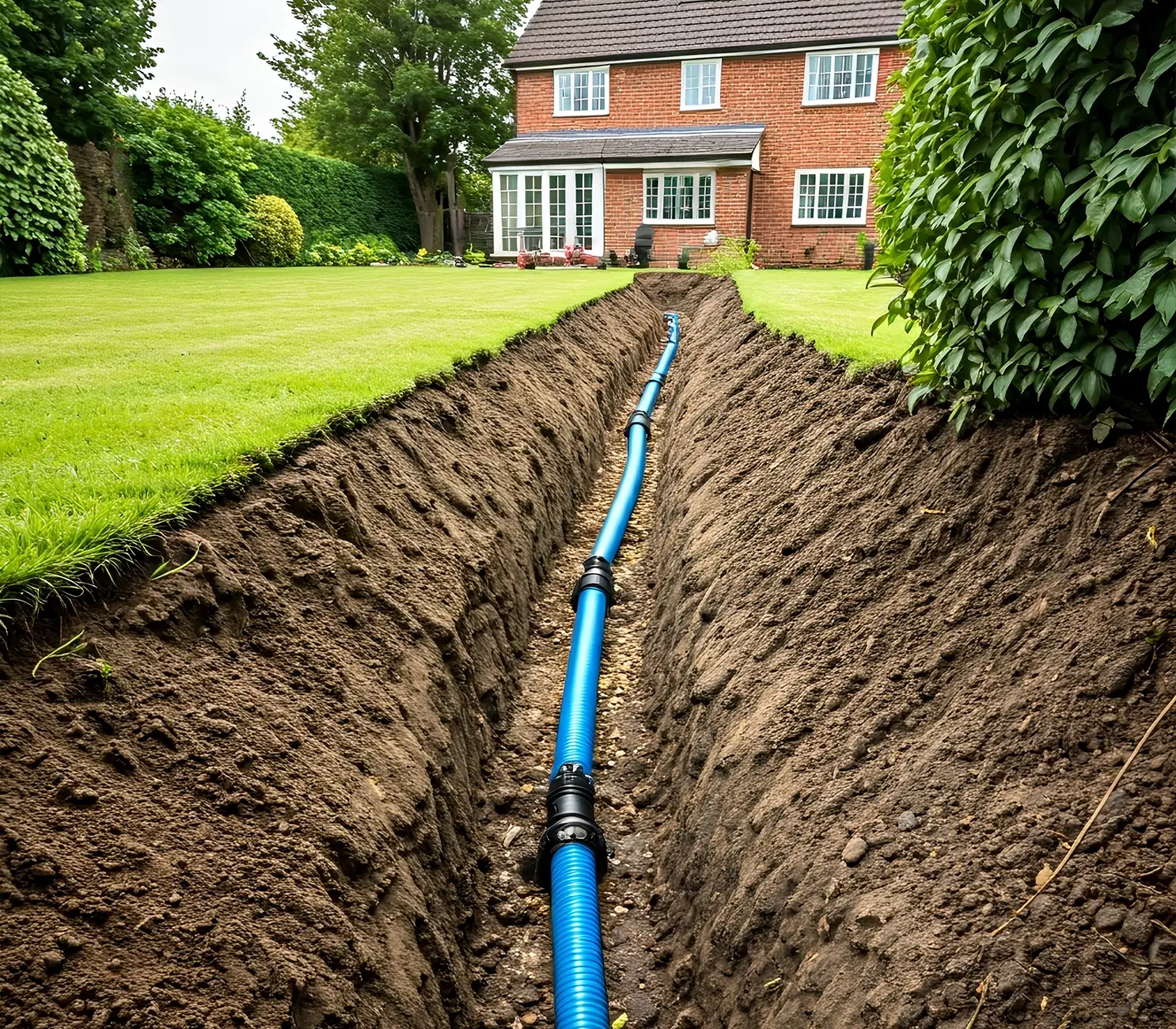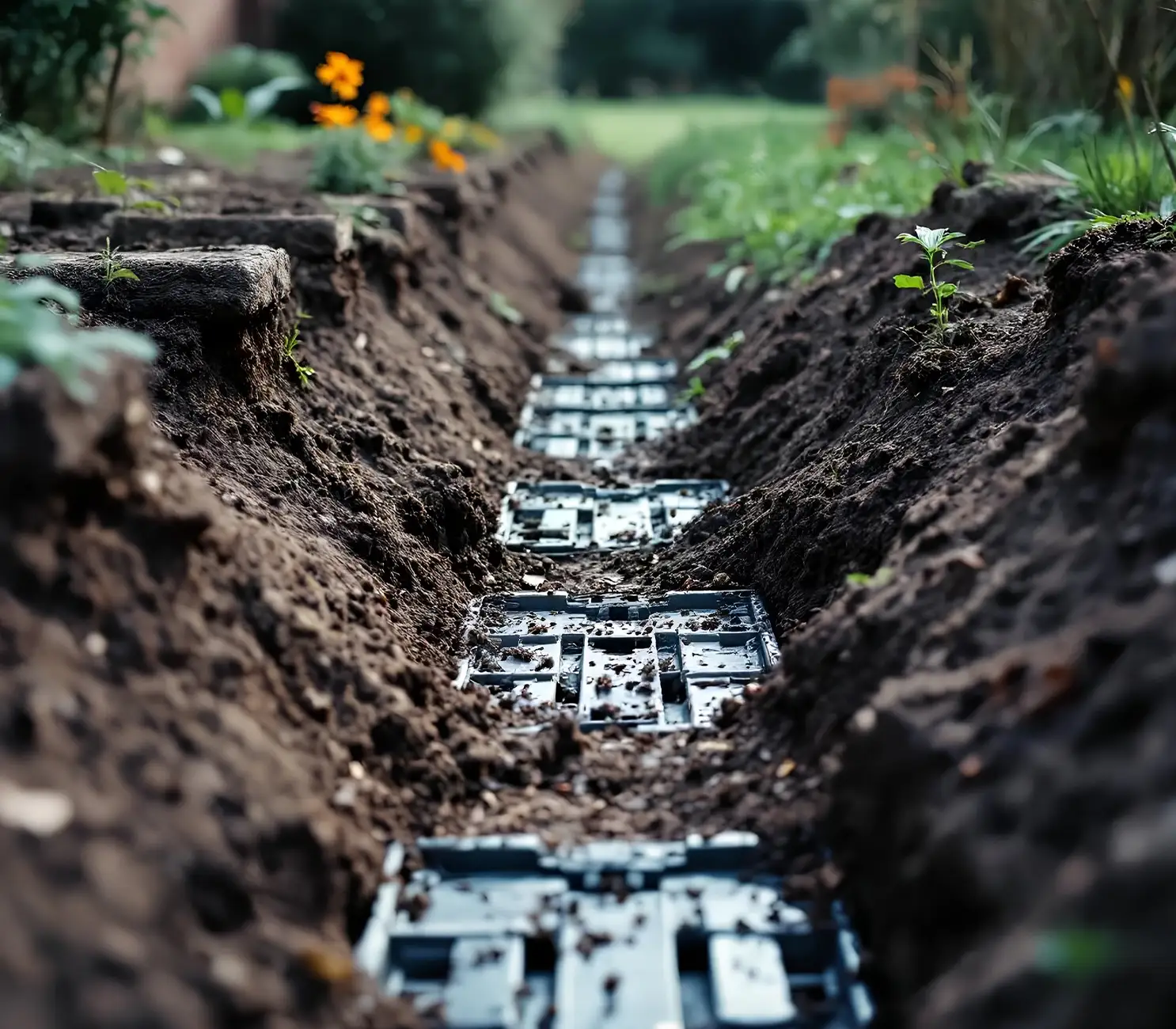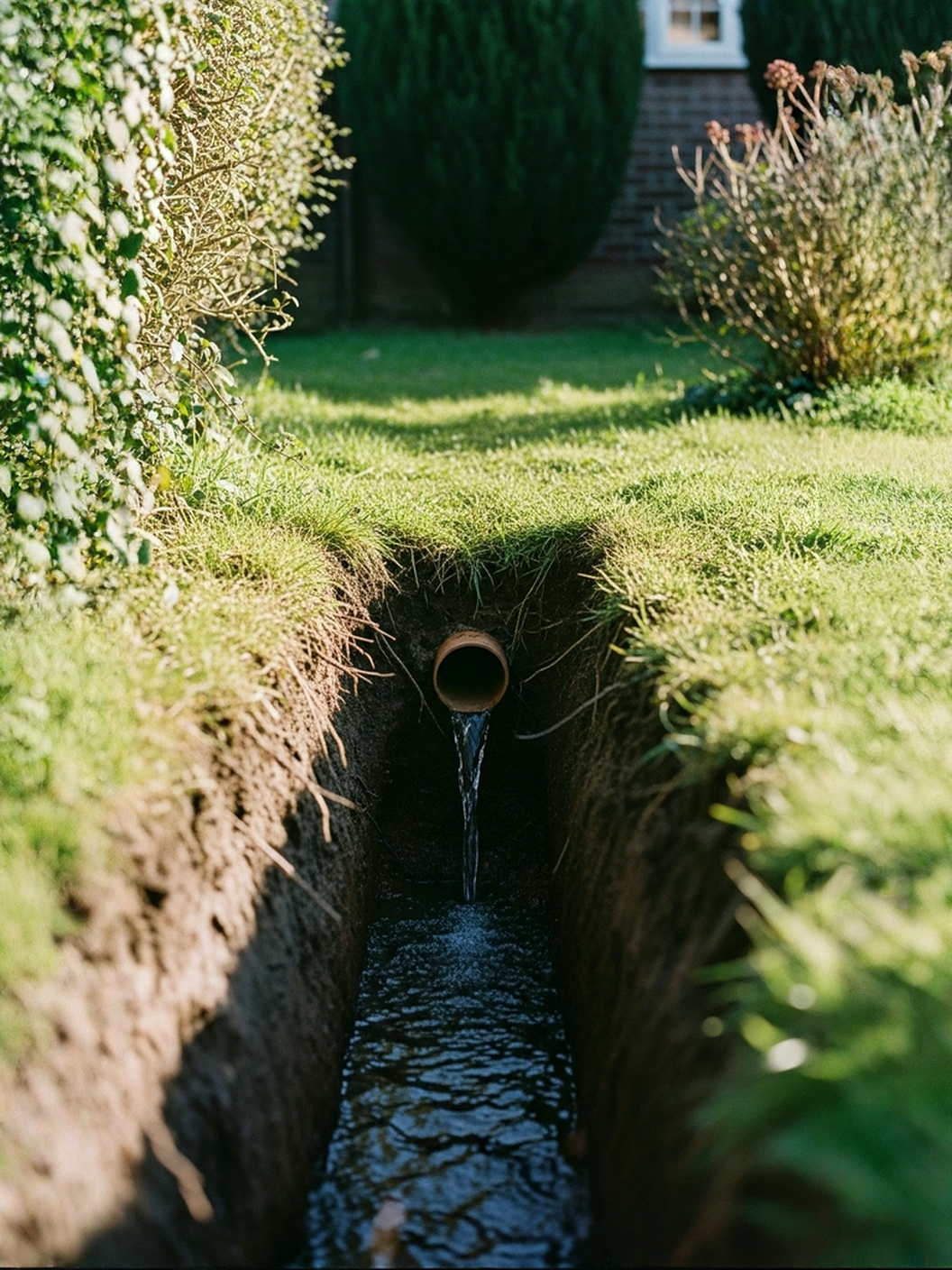Professional Soakaway Installation Services
WHAT WE OFFER
Fed up with waterlogged gardens or flooding issues on your property? These problems damage foundations and soil quality.
We offer soakaway installation services for managing excess water through professionally installed systems. Our team ensure full compliance with building and local regulations, get in touch for your free quote.
Modern
Equipment
Latest machinery and excavators with the latest technology.
Building Regulations Compliant
All installations meet building regulations and specifications.
Safety
First
Fully qualified operators with comprehensive safety protocols.
End-to-End
Service
From site preparation to final restoration with one company.
What Is a Soakaway and How Does It Work?
A soakaway is an underground solution to manage excess water by releasing it into the ground naturally. Rainwater and surface water enters through the inlet pipe into a gravel filled chamber. Systems collect water from roofs or driveways, the surrounding soil absorbs the water as it disperses. This prevents flooding and protects your property and gardens.
System Effectiveness Factors
Effectiveness depends on:
- Soil assessment and SUDS manual guidelines
- Soil conditions – loamy or sandy soil for better water absorption
- Infiltration rate – how quickly water disperses from the system into the ground
We assess the ground conditions thoroughly to ensure the system works optimally. Professional systems integrate with existing infrastructure to provide full water management solutions for any property.

Soakaway Systems
Choosing the right system is key to water management and long term performance. There are two main types used in domestic and commercial applications:
Modular Soakaway Systems
Made up of multiple plastic crates (modular water storage cells) connected to form a large pit. Key benefits:
Flexibility - tailored to specific catchment areas and water volumes
Protection - wrapped in geotextile membrane to prevent soil particles entering
Effectiveness - particularly good for heavy clay soil areas where they prevent ground settlement
Expandability - modular design allows for future expansion
Traditional Soakaway Pits
We dig a large hole and fill with rubble or aggregate. Best for domestic applications in sandy or loamy soil where water can infiltrate naturally through free draining soil layers.
Selection Factors
When choosing a system consider:
Soil type (sandy, loamy, clay)
Catchment area size - how big the hole will be
Surface water volume
Local authority regulations and building codes
Specific requirements (pre-formed knockout sections, geotextile membrane types)
We evaluate to ensure effective drainage, prevent ground settlement and protect your property from water related issues whilst being compliant with regulations.

Soakaway Install - Planning and Preparation
Proper planning and preparation is key to a successful project. Before work starts, assess your property’s individual needs to ensure water management and compliance with regulations.
Initial Assessment Requirements
Assess your catchment area (roofs, driveways, car parks) to calculate water volume:
- Roof area calculations for cubic metre capacity
- Soil type – Clay soil affects water absorption
- Percolation testing to determine soil drainage and inform design
Percolation tests show how quickly water moves through the soil. This is crucial for system sizing and to ensure water from inlet pipes is released slowly and doesn’t flood.

Material Selection and Installation
Soakaway crates are robust when combined with:
Sharp sand for bedding
Pea shingle for structure
Geotextile membrane for protection
Side fill materials for water dispersal
Plastic soakaway crates must be installed at the correct depth and tied in with cable ties. Soakaway crates work on impermeable surfaces and can take 80 tonnes of vehicles.
Pre-Installation Requirements
Before installation:
Check underground services (pipes/cables) to avoid damage
Clear and support the area to prevent soil erosion
Design top cover for traffic loads
Plan pipe entry points for water flow
Compliance and Costs
Local authorities may require planning permission in high water tables or flood zones. Check with your local authority.
Installation costs depend on size, depth, materials and complexity. In difficult conditions (clay soil, high water tables) silt traps, pre-filters or French drains may be required.
Proper planning means your project is efficient, cost effective and compliant – protecting your property from excess water and future problems.
Our Soakaway Crates Installation Process
Plant Hire Now delivers expert services combining technical knowledge with project management. Our process starts with a site visit to assess the soil, access requirements and positioning for your property. We ensure the correct placement relative to buildings and calculate the exact depth required based on ground conditions and regulations.
Our technicians handle everything from excavation to testing:
Dig to specification
Install soakaway crates and materials
Connect inlet pipe systems
Provide gravel bedding and backfilling for long term stability
Install inspection chambers for future maintenance access
Restore area back to original condition upon completion
We manage access around driveways or gardens and integrate with existing French drain systems and pipe leading connections.
Soakaway Drainage System Installation Costs and Factors
Soakaway cost is affected by several variables:
Key Costs
- Property size and access – restricted access means special equipment required
- Excavation costs – depends on site conditions and depth required
- System depth – depends on soil conditions, regulations and water volume needed
- Project complexity – affected by existing systems, driveway position and garden requirements
Sites with difficult soil or limited access need extra prep work which adds to the overall cost.
We give you transparent pricing so you know all costs upfront, materials, labour and certification. We provide a detailed quote with everything included and no hidden extras.
Installation Mistakes to Avoid
Proper installation is key to long term success but several common mistakes can compromise performance and cost you money.
The biggest mistake is not doing percolation tests. These tests are crucial to determine if the surrounding soil can absorb water especially in areas with clay soil or poor drainage.
Poor material choices and installation techniques cause big problems:
- No geotextile membrane protection - Without this layer soil particles get into the system and cause blockages and reduced water dispersal.
- Wrong bedding materials - Sharp sand or pea shingle is essential for stability and drainage; wrong materials cause ground settlement or pipe damage.
- Bad connections - Poorly sealed or misaligned pipe entry points prevent water from entering the system or overwhelm the system during heavy rain.
Not providing enough access points or cleaning eyes makes maintenance a nightmare, and you’ll miss blockages, and performance will suffer.
Not complying with local authority regulations and building codes can mean fines, penalties or costly modifications. Essential compliance requirements are:
- Correct installation depth
- Enough side fill to support crates and protect from ground movement
- Compliance with local building standards
Professional Installation Benefits
Avoiding these mistakes—skipping percolation tests, neglecting protective membranes, using improper materials, and overlooking regulatory requirements—ensures your soakaway system functions efficiently and remains compliant. Professional installation following best practices drastically reduces the risk of future problems and maintenance issues.
Why Choose Professional Installation?
Going the professional route ensures compliance and results. Many property owners wonder if they can install a soakaway themselves. However, the technical know-how for soil testing, depth calculations, and system design means hiring a professional is essential.
Correctly installed systems prevent costly future problems like foundation damage and persistent flooding. Hiring a professional includes proper soil testing, precise positioning calculations and quality materials for optimal performance.
We have the specialist equipment for excavation and testing procedures that amateurs can’t replicate. Installing a soakaway requires expertise in soakaway crate positioning and side fill techniques.
services available throughout
- Avon
- Bedfordshire
- Berkshire
- Buckinghamshire
- Cambridgeshire
- Cheshire
- Cornwall
- Cumbria
- Derbyshire
- Devon
- Dorset
- Durham
- Essex
- Gloucestershire
- Greater London
- Hampshire
- Herefordshire
- Hertfordshire
- Isle of Wight
- Kent
- Lancashire
- Leicestershire
- Lincolnshire
- Merseyside
- Norfolk
- Northamptonshire
- Northumberland
- Nottinghamshire
- Oxfordshire
- Rutland
- Schools
- Shropshire
- Somerset
- Staffordshire
- Suffolk
- Surrey
- Sussex
- Tyne and Wear
- Warwickshire
- West Midlands
- Wiltshire
- Worcestershire
- Yorkshire
FAQs
Depth depends on soil type, property requirements and proximity to building. Standard installations are 1.5-3m deep but site conditions may require different positioning. Deep bore systems are drilled like water wells.
We assess each property individually to determine the optimal depth required and ensure it works effectively and safely.
Most soakaways are ‘permitted development’ but some are not. Local regulations vary across council areas so professional advice is key. You don’t need planning permission to replace a soakaway on your land so it’s much simpler for homeowners. We handle the regulatory consultations so your project meets all the rules and gets planning permission where required.
Systems installed to industry standards require minimal maintenance, usually just annual inspections. Regular checks ensure inlet pipe systems are clear and access points are unobstructed. Our maintenance services include full system checks and performance optimisation.
Required permissions:
- Planning approval from your council
- Building control sign off
- Structural engineer validation
Permissions vary from council to council and project to project. Ground conditions and local development policies dictate what basement work gets approved in your area.
We take care of all the permission applications. Our staff submit the paperwork and communicate with council planners and building inspectors on your behalf.
Application stages include:
- Creating detailed construction and engineering plans
- Getting council planning and building approvals
- Organising build stage inspections
- Meeting all construction safety and design codes
We guide your application through each stage of the process to prevent approval delays that could stop your basement project.
Get Your Soakaway Installation Quote Now
Transform your water management with Plant Hire Now. Our expert team delivers professional solutions to protect your investment and meet regulations. Whether you’re dealing with flooding or planning to improve, we have the expertise.
Call us today for your free consultation and quote. We’ll assess your requirements, recommend the best solution and give you a transparent price for your project.

